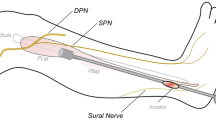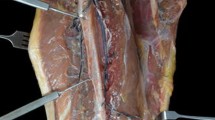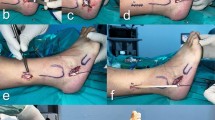Abstract
Purpose
This study aims to evaluate the proximity of the tendon stripper to both the peroneal and sural nerves during peroneus longus tendon (PLT) autograft harvesting.
Methods
Ten fresh–frozen human cadaveric lower extremities were used to harvest a full-thickness PLT autograft using a standard closed blunt-ended tendon stripper. The distance to the sural nerve from the PLT (at 0, 1, 2 and 3 cm proximal to lateral malleolus (LM), and the distance to the peroneal nerve and its branches from the end of the tendon stripper were measured by two separate observers using ImageJ software.
Results
The average distance from the PLT to the sural nerve increased significantly from 0 to 2 cm proximal to LM. The average distance to the sural nerve at the LM was 4.9 ± 1.5 mm and increased to 10.8 ± 2.4 mm (2 cm proximal to LM). The average distance from the tendon stripper to the deep peroneal nerve was 52.9 ± 11.4 mm. The average distance to the PLT branch of peroneal nerve was 29.3 ± 4.2 mm. The superficial peroneal nerve, which coursed parallel and deep to the tendon stripper, was on average 5.2 ± 0.7 mm from the end of the stripper. No transection injuries of the nerves were observed in any of the ten legs after harvesting.
Conclusion
This cadaver study found during a full-thickness PLT harvest, the distances between the tendon stripper and the nerves were greater than 5 mm with an initial incision at 2 cm proximal to LM which is recommended.



Similar content being viewed by others
Abbreviations
- ACL:
-
Anterior cruciate ligament
- PLT:
-
Peroneus longus tendon
- LM:
-
Lateral malleolus
- PBT:
-
Peroneus brevis tendon
- ICC:
-
Intraclass correlation coefficient
References
Aktan Ikiz ZA, Üćerler H, Bilge O (2005) The anatomic features of the sural nerve with an emphasis on its clinical importance. Foot Ankle Int 26:560–567
Angthong C, Chernchujit B, Apivatgaroon A, Chaijenkit K, Nualon P, Suchao-In K (2015) The anterior cruciate ligament reconstruction with the peroneus longus tendon: a biomechanical and clinical evaluation of the donor ankle morbidity. J Med Assoc Thail 98:555–560
Baumgart C, Welling W, Hoppe MW, Freiwald J, Gokeler A (2018) Angle-specific analysis of isokinetic quadriceps and hamstring torques and ratios in patients after ACL-reconstruction. BMC Sports Sci Med Rehabil 10:1–8
Blakey CM, Biant LC (2008) Transection of the common peroneal nerve during harvesting of tendons for anterior cruciate ligament reconstruction: a case report. J Bone Joint Surg Am 90:1567–1569
Budhiparama NC, Rhatomy S, Phatama KY, Chandra W, Santoso A, Lumban-Gaol I (2021) Peroneus longus tendon autograft: a promising graft for ACL reconstruction. Video J Sport Med 1:26350254211009890
Buntic RF, Buncke HJ, Kind GM, Chin BT, Ruebeck D, Buncke GM (2002) The harvest and clinical application of the superficial peroneal sensory nerve for grafting motor and sensory nerve defects. Plast Reconstr Surg 109:145–151
Castile R, Jenkins M, Lake S, Brophy R (2020) Microstructural and mechanical properties of grafts commonly used for cruciate ligament reconstruction. J Bone Joint Surg Am 102:1948–1955
Cicchetti DV (1994) Guidelines, criteria, and rules of thumb for evaluating normed and standardized assessment instruments in psychology. Psychol Assess 6:284–290
Eid EM, Hegazy AMS (2011) Anatomical variations of the human sural nerve and its role in clinical and surgical procedures. Clin Anat 24:237–245
Encarnación-Martínez A, Sanchis-Sanchis R, Pérez-Soriano P, García-Gallart A (2020) Relationship between muscular extensibility, strength and stability and the transmission of impacts during fatigued running. Sport Biomech. https://doi.org/10.1080/14763141.2020.1797863
de Oliveira DE, Zaccharias VP, Horita MM, Guglielmetti LGB, Junior AD, Jorge PB (2021) Anterior cruciate and anterolateral ligament reconstruction using hamstring and peroneus longus tendons: surgical technique description. Arthrosc Tech 10:e397–e402
Goss DA, Reb CW, Philbin TM (2017) Anatomic structures at risk when utilizing an intramedullary nail for distal fibular fractures: a cadaveric study. Foot Ankle Int 38:916–920
Grassi A, Perdisa F, Samuelsson K, Svantesson E, Romagnoli M, Raggi F, Gaziano T, Mosca M, Ayeni O, Zaffagnini S (2018) Association between incision technique for hamstring tendon harvest in anterior cruciate ligament reconstruction and the risk of injury to the infra-patellar branch of the saphenous nerve: a meta-analysis. Knee Surg Sports Traumatol Arthrosc 26:2410–2423
Hallgren K (2012) Computing inter-rater reliability for observational data: an overview and tutorial. Tutor Quant Methods Psychol 8:23–34
He J, Tang Q, Ernst S, Linde MA, Smolinski P, Wu S, Fu F (2020) Peroneus longus tendon autograft has functional outcomes comparable to hamstring tendon autograft for anterior cruciate ligament reconstruction: a systematic review and meta-analysis. Knee Surg Sports Traumatol Arthrosc. https://doi.org/10.1007/s00167-020-06279-9
Hildebrand G, Tompkins M, Macalena J (2015) Fibular head as a landmark for identification of the common peroneal nerve: a cadaveric study. Arthroscopy 31:99–103
Hohmann E, Keough N, Glatt V, Tetsworth K, Putz R, Imhoff A (2019) The mechanical properties of fresh versus fresh/frozen and preserved (Thiel and Formalin) long head of biceps tendons: a cadaveric investigation. Ann Anat 221:186–191
Jowett AJL, Sheikh FT, Carare RO, Goodwin MI (2010) Location of the sural nerve during posterolateral approach to the ankle. Foot Ankle Int 31:880–883
Kerimoǧlu S, Aynaci O, Saracoǧlu M, Aydin H, Turhan AU (2008) Anterior cruciate ligament reconstruction with the peroneus longus tendon. Acta Orthop Traumatol Turc 42:38–43
Lawrence SJ, Botte MJ (1995) The deep peroneal nerve in the foot and ankle: an anatomic study. Foot Ankle Int 16:724–728
Lee HW, Wang C, Bae TS, Yang I, Liu Y, Park CW, Kim HN (2020) Tendon regeneration after partial-thickness peroneus longus tendon harvesting: magnetic resonance imaging evaluation and in vivo animal study. Am J Sports Med 48:2499–2509
Lynch AD, Logerstedt DS, Grindem H, Eitzen I, Hicks GE, Axe MJ, Engebretsen L, Risberg MA, Snyder-MacKler L (2015) Consensus criteria for defining “successful outcome” after ACL injury and reconstruction: a Delaware-Oslo ACL cohort investigation. Br J Sports Med 49:335–342
Malagelada F, Vega J, Guelfi M, Kerkhoffs G, Karlsson J, Dalmau-Pastor M (2020) Anatomic lectures on structures at risk prior to cadaveric courses reduce injury to the superficial peroneal nerve, the commonest complication in ankle arthroscopy. Knee Surg Sports Traumatol Arthrosc 28:79–85
Meislin R (2018) Editorial commentary: you have some (infrapatellar branch of the saphenous) nerve! Arthroscopy 34:2884–2885
Mestdagh H, Drizenko A, Maynou C, Demondion X, Monier R (2001) Origin and make up of the human sural nerve. Surg Radiol Anat 23:307–312
Musahl V, Karlsson J (2019) Anterior cruciate ligament tear. N Engl J Med 380:2341–2348
Orchard JW, Chaker Jomaa M, Orchard JJ, Rae K, Hoffman DT, Reddin T, Driscoll T (2020) Fifteen-week window for recurrent muscle strains in football: a prospective cohort of 3600 muscle strains over 23 years in professional Australian rules football. Br J Sports Med 54:1103–1107
Pereira BS, Pereira H, Robles RV, Rivas AP, Nar ÖO, Espregueira-Mendes J, Oliva XM (2019) The distance from the peroneal tendons sheath to the sural nerve at the posterior tip of the fibula decreases from proximal to distal. Knee Surg Sports Traumatol Arthrosc 27:2852–2857
Rhatomy S, Asikin AIZ, Wardani AE, Rukmoyo T, Lumban-Gaol I, Budhiparama NC (2019) Peroneus longus autograft can be recommended as a superior graft to hamstring tendon in single-bundle ACL reconstruction. Knee Surg Sports Traumatol Arthrosc 27:3552–3559
Rhatomy S, Hartoko L, Setyawan R, Soekarno NR, Zainal Asikin AI, Pridianto D, Mustamsir E (2019) Single bundle ACL reconstruction with peroneus longus tendon graft: 2-years follow-up. J Clin Orthop Trauma. 11:S332–S336. https://doi.org/10.1016/j.jcot.2019.09.004
Rhatomy S, Wicaksono FH, Soekarno NR, Setyawan R, Primasara S, Budhiparama NC (2019) Eversion and first ray plantarflexion muscle strength in anterior cruciate ligament reconstruction using a peroneus longus tendon graft. Orthop J Sports Med 7:2325967119872462
Ribak S, Fonseca JR, Tietzmann A, Gama SAM, Hirata HH (2016) The anatomy and morphology of the superficial peroneal nerve. J Reconstr Microsurg 32:271–275
Setyawan R, Soekarno NR, Asikin AIZ, Rhatomy S (2019) Posterior cruciate ligament reconstruction with peroneus longus tendon graft: 2-years follow-up. Ann Med Surg 43:38–43
Shao X, Shi LL, Bluman EM, Wang S, Xu X, Chen X, Wang J (2020) Satisfactory functional and MRI outcomes at the foot and ankle following harvesting of full thickness peroneus longus tendon graft. Bone Joint J 102:205–211
Solomon LB, Ferris L, Tedman R, Henneberg M (2001) Surgical anatomy of the sural and superficial fibular nerves with an emphasis on the approach to the lateral malleolus. J Anat 199:717–723
Tapasvi SR, Shekhar A, Patil SS (2019) Anatomic posterolateral corner reconstruction with autogenous peroneus longus Y graft construct. Arthrosc Tech 8:e1501–e1509
Watt T, Hariharan AR, Brzezinski DW, Caird MS, Zeller JL (2014) Branching patterns and localization of the common fibular (peroneal) nerve: an anatomical basis for planning safe surgical approaches. Surg Radiol Anat 36:821–828
Zhao J, Huangfu X (2012) The biomechanical and clinical application of using the anterior half of the peroneus longus tendon as an autograft source. Am J Sports Med 40:662–671
Zhao J, Huangfu X, He Y (2012) The role of medial retinaculum plication versus medial patellofemoral ligament reconstruction in combined procedures for recurrent patellar instability in adults. Am J Sports Med 40:1355–1364
Acknowledgements
The authors appreciate Dr. Caiqi Xu and Dr. Feng Qu discussing the procedure among harvesting peroneus longus tendon autograft.
Funding
JH is a visiting scholar and supported by the program of China Scholarships Council and the National Natural Science Foundation of China (No. 81802208).
Author information
Authors and Affiliations
Contributions
JH performed the dissection of cadavers and the collection of all data. KB, HU and RK assisted in the dissection of cadavers and collection of all data. JH, KB and ML drafted and edited the original manuscript. JH, ML, PS, SW and FF participated in the conception and design of the original study. All the authors read and approved the final manuscript.
Corresponding author
Ethics declarations
Conflict of interest
The authors declare no conflicts of interest.
Ethical approval
Approval for this study and use of cadaver specimens was obtained from the University of Pittsburgh Committee for Oversight of Research and Clinical Training Involving Decedents (CORID #453).
Informed consent
No informed consent was required for this study.
Additional information
Publisher's Note
Springer Nature remains neutral with regard to jurisdictional claims in published maps and institutional affiliations.
Investigation performed at the Department of Orthopaedics, University of Pittsburgh, Pittsburgh, Pennsylvania, USA.
Supplementary Information
Below is the link to the electronic supplementary material.
167_2021_6698_MOESM1_ESM.tif
Supplementary Fig. 1 Photographed step. 1 of peroneus longus tendon (PLT) harvest. The left suture with white and light blue was used to mark the proximal part of PLT, the right suture with deep blue was used to mark the distal segment of PLT. The PLT was transected between the two sutures (TIF 26640 KB)
167_2021_6698_MOESM2_ESM.tif
Supplementary Fig. 2 Photographed step. 2 of peroneus longus tendon (PLT) harvest. PLT was transected, and the posterior tendon with white and light blue suture was the PLT autograft. The anterior tendon was the peroneus brevis tendon stitched with distal segment of PLT marked with blue suture to preserve the function of PLT (TIF 24892 KB)
167_2021_6698_MOESM3_ESM.tif
Supplementary Fig. 3 Double-check of peroneus longus tendon (PLT) harvest. PLT autograft had been harvested, and the distal lateral compartment of ankle was exposed to visualize the end point of peroneus brevis tendon (PBT). The PBT is intact, and the proximal part of PLT was harvested. It is important to not accidentally harvest the PBT instead of PLT (TIF 36208 KB)
167_2021_6698_MOESM4_ESM.tif
Supplementary Fig. 4 Peroneus longus tendon (PLT) autograft preparation. PLT was prepared with double-strand and measured with graft sizer (8.5 mm in diameter) (TIF 4642 KB)
Supplementary Video 1 Captured steps of peroneus longus tendon harvest (MP4 13276 KB)
Rights and permissions
About this article
Cite this article
He, J., Byrne, K., Ueki, H. et al. Low to moderate risk of nerve damage during peroneus longus tendon autograft harvest. Knee Surg Sports Traumatol Arthrosc 30, 109–115 (2022). https://doi.org/10.1007/s00167-021-06698-2
Received:
Accepted:
Published:
Issue Date:
DOI: https://doi.org/10.1007/s00167-021-06698-2




